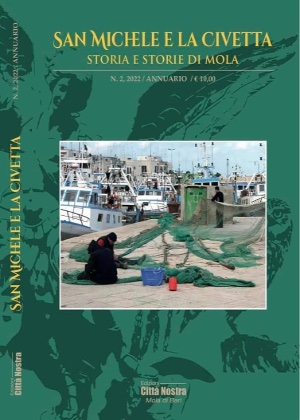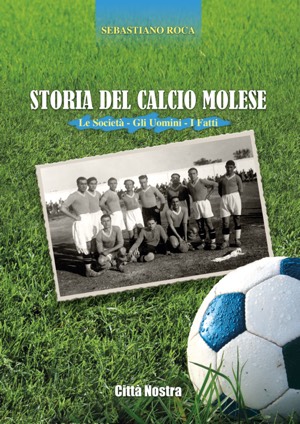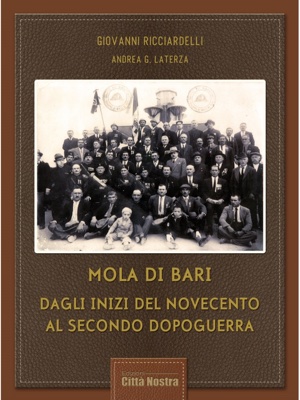di Rosa Pietanza
 Seventy Years of the Congrega Maria S.S. Addolorata (“Settant’anni della Congrega di Maria S.S. Addolorata”)
Seventy Years of the Congrega Maria S.S. Addolorata (“Settant’anni della Congrega di Maria S.S. Addolorata”)
L’articolo che segue è stato scritto da Rosa Pietanza che vive e lavora a New York. La sua presenza all’interno della comunità molese di Brooklyn (NY) ci permette di instaurare un ponte tra i due luoghi al mondo in cui vivono più molesi: Mola e New York. Avremo la possibilità di avere uno sguardo privilegiato, di una native speaker di origini italiane (i suoi genitori sono nati a Mola), sulla realtà americana. In calce all’articolo in inglese vi è un breve sunto in italiano. Nostro auspicio è che questo tipo di intervento possa interessare a coloro che conoscono l’inglese ma anche a coloro che lo studiano; infatti questi articoli in lingua inglese potrebbero essere utilizzati come materiale didattico all’interno delle scuole molesi (F. Spilotros).
Caputo, Colonna, Deliso, Ingravallo, Pesce, Rotondi, Russo are some of the names found on the “1948 Elenco Degli Offerenti Pro Immagine Maria SS Addolorata,” appearing in the annual advertisement book distributed by the Congrega Maria SS Addolorata during its 2018 Christmas Gala. They, together with other familiar names, were the Molese Brooklyn residents, who, along with friends in Mola – including our beloved Don Bruno Aloia, Don Vito Iacovelli and the Poor Clares – seventy years ago, pooled financial and nonfinancial resources to bring a replica of the Madonna Addolorata statue to Brooklyn.
Turning to the Congrega’s 2018 membership list, one again sees Caputo, Colonna, Deliso, Ingravallo, Pesce, Rotondi, Russo – those and other typical surnames that have passed down through generations and identify us as “Molese.” But, running deeper, are our shared history, communal experiences, and valued traditions – perhaps the strongest, our devotion to Mola’s patron saint. It was this devotion that compelled the Congrega’s founding members to bring the statue of the Madonna Addolorata to Brooklyn. With foresight to understand that many immigrants would not return home, those members knew the statue would serve to forever link the new Americans to Mola.
Panning the 1948 list, I stumble upon an “Angelo Rago” and wonder if he was the man who would forever change the course of my family’s history, petitioning the passage of his sister, my grandmother, to America. If not my great-uncle, the listed “Angelo Rago” was no doubt his relative or dear friend, because a few facts are known about Molese-American history: that Molesi, for the most part, first planted their new roots in Carroll Gardens, Brooklyn, attended Sacred Hearts of Jesus and Mary & St. Stephen (“St. Stephen’s”) Roman Catholic Church, filled the apartments of Sackett, DeGraw, President, Henry, and Court Streets, and paved the way for thousands more friends and family, most of whom would come through the 1960s.
 With the influx of Molesi, the predominantly Irish Carroll Gardens started to transform; Molese-owned businesses began to open and the dialect could be heard spoken in its streets. Molese immigrants – aliens in an enormous, diverse city, forced to accept new jobs or professions, and challenged to learn at an advanced age a foreign language – found solace in their “paesani,” who were enduring similar hardships. Leaning on each other, many would begin referring to their Molese friends as “compare” because their bond as compatriots was likely stronger than others they would form in their adoptive home (Nella foto sono presenti giovani portatori pronti per uscire con la statua della Madonna in occasione della 70ma processione: 8 settembre 2018).
With the influx of Molesi, the predominantly Irish Carroll Gardens started to transform; Molese-owned businesses began to open and the dialect could be heard spoken in its streets. Molese immigrants – aliens in an enormous, diverse city, forced to accept new jobs or professions, and challenged to learn at an advanced age a foreign language – found solace in their “paesani,” who were enduring similar hardships. Leaning on each other, many would begin referring to their Molese friends as “compare” because their bond as compatriots was likely stronger than others they would form in their adoptive home (Nella foto sono presenti giovani portatori pronti per uscire con la statua della Madonna in occasione della 70ma processione: 8 settembre 2018).
The Congrega, initially led by Luigi Caputo, was vital to the survival of early immigrants. John Ingravallo, President for over the last 14 years, recalls when Congrega members (at the direction of former Secretary, Joe Gentile) would knock door to door to provide notice of events and seek donations. These types of interactions, in turn, deepened relationships within the community, unified by its loyalty to the Madonna.
Just three years following the end of World War II, the war that for some time had pitted them against Italy, the Madonna’s statue was one of the most welcome and necessary additions to their Brooklyn family. To many, the statue may have symbolized the melancholic realization that they would not be returning to Mola’s blue skies and pristine sea views.
To others quite happy to stay, she at least shortened the distance – though falsely in the way video chats and email do today – to their homeland. At least two days a year, they would feel united with family and friends in Mola, processing through the streets of their new home, because whether they would stay or return, their devotion to the Madonna Addolorata was something they refused to leave behind.
Today, gathering at its clubhouse at 7413 15th Avenue, Brooklyn, just feet away from the street corner named, “Alberto Ingravallo Way,” in honor of our late friend, the Congrega continues to celebrate the Madonna. The group, boasting over 200 members, prays the rosary regularly, not only every first Tuesday of the month, but again, during the month of May, facing an alter erected in the Holy Mother’s honor, and for a novena prior to the September procession. On each of the Wednesdays preceding Good Friday and the feast day of Our Lady of Sorrows, a select few sorelle ritualistically dress the statue, in black for mourning, and gold and black for the feast day.
 During the Christmas season, the Congrega holds an event to commemorate the birth of Christ, singing Tu Scendi dalle Stelle while placing baby Jesus in its beautiful presepio. Over the years, the Congrega has held numerous fundraisers to assist some of its own members undergoing painful experiences, including a devastating house fire and debilitating illness, expressing solidarity in time of need. On a larger scale, the Congrega has responded generously to natural disasters, helping victims of the major earthquakes in Italy and hurricanes in the United States (Nella foto di Giovanni Sciannameo è presente la Processione di venerdì santo, 30 marzo 2018 – Sorelle della Congreda a Carroll Gardens, Brooklyn).
During the Christmas season, the Congrega holds an event to commemorate the birth of Christ, singing Tu Scendi dalle Stelle while placing baby Jesus in its beautiful presepio. Over the years, the Congrega has held numerous fundraisers to assist some of its own members undergoing painful experiences, including a devastating house fire and debilitating illness, expressing solidarity in time of need. On a larger scale, the Congrega has responded generously to natural disasters, helping victims of the major earthquakes in Italy and hurricanes in the United States (Nella foto di Giovanni Sciannameo è presente la Processione di venerdì santo, 30 marzo 2018 – Sorelle della Congreda a Carroll Gardens, Brooklyn).
These and various social activities, such as its classical concerts featuring Molese performers, “panzerottate,” and Pasquetta and Ferragosto gatherings, respect Molese customs, and others, such as pilgrimages to the Basilica of the National Shrine of the Immaculate Conception in Washington, D.C., and the annual Thanksgiving meals, pay homage to newly acquired American traditions.
On December 16, 2018, over 300 people, including past President, Giovanni Teutonico, recognized the Congrega’s 70th Anniversary by attending its Christmas Gala. The Man of the Year, Michael Cama, a second generation Italian-American, only one-quarter Molese, spoke of his strong connection to Mola, proof that future generations will continue to have a fondness for their ancestors’ hometown. Business Man of the Year, Domenico Nuzzi, born in Mola, raised in Carroll Gardens, and now residing in New Jersey, exemplifies the Molese experience in America.
In his speech, Mr. Nuzzi thanked those who helped him achieve his dreams – many paesani in the room, the same men and women, who throughout the years, walked alongside him in the processions. Beginning and ending at St. Stephen’s, where the statue is kept year-round, the procession briefly pauses for refreshments at the Van Westerhout Cittadini Molesi Cultural, Sport & Social Club, on Court Street and 4th Place, officially known as “Citizens of Mola di Bari Way.” The sorelle, wearing black, chant Italian prayers and hymns, while fratelli, dressed in tuxedos, lift and carry the statue on their shoulders.
 As they walk, many point to their first American homes and recall old neighbors, who, maybe unknown to them in Mola, here, in Brooklyn, became their tribe. Now scattered across other cities and states, including New Jersey, Staten Island, and Westchester, these members return to Carroll Gardens for the processions, perhaps with nostalgia, longing a bit for that time when community was family. They return to express gratitude to their paesani and to the Madonna herself, for guidance and support provided in their early immigrant days (Nella foto ci sono giovani sorelle neo iscritte alla Congreda della Madonna SS. Addolorata).
As they walk, many point to their first American homes and recall old neighbors, who, maybe unknown to them in Mola, here, in Brooklyn, became their tribe. Now scattered across other cities and states, including New Jersey, Staten Island, and Westchester, these members return to Carroll Gardens for the processions, perhaps with nostalgia, longing a bit for that time when community was family. They return to express gratitude to their paesani and to the Madonna herself, for guidance and support provided in their early immigrant days (Nella foto ci sono giovani sorelle neo iscritte alla Congreda della Madonna SS. Addolorata).
For this first generation American and newly inducted sorella, the processions evoke memories of my grandmother, shedding tears in remembrance of her long-deceased husband and of her brother, Angelo, as the statue passed her on President Street. They remind me of the dedication of my parents and other sorelle and fratelli, who raise money for events, coordinate with city and Church officials in their thick Italian accents, but still are understood, and who always show up and walk for over three hours. I think of their compari, many whose children I now call friends, who provided help and advice along the way.
As fewer Molesi reside in Carroll Gardens, and as Farrells, Kobels, Heyers, and Prues replace the “Molese” surnames on the Congrega’s membership lists, it seems increasingly important to carry on our customs. We – now American, sons and daughters of Molese immigrants, along with our recently arriving compatriots, products of Italy’s great, current “fuga,” to whom we similarly extend a welcoming hand – must not forget traditions born under the blue skies of that seaside town we carry in our hearts.
While several Molese social and cultural organizations, such as the Van Westerhout Cittadini Molesi Cultural, Sport & Social Club, provide opportunities to promote our heritage, the Congrega most symbolically expresses, through its processions, the unique Molese immigrant experience. As we spread throughout this vast country, we rest assured knowing we can gather in the place our ancestors first landed, venerate in our unique way, Mola’s patron saint, and while we reflect on the distances traveled, fulfill the vision of the Congrega’s founding members by exhibiting and celebrating for generations to come, our identity, our Molesità.
RIASSUNTO
 Quest’anno la Congrega di Maria SS Addolorata di Brooklyn ha celebrato il suo 70mo anniversario. Con l’aiuto di Don Bruno Aloia, Don Vito Iacovelli, le Suore Clarisse e altri molesi, nel 1948 venne portata a Brooklyn una copia della statua della Madonna Addolorata di Mola. Questo evento avrebbe per sempre ulteriormente legato Mola con Brooklyn. Forse per alcuni simboleggiò la dura decisione di restare qui in America, ma servì in un certo modo agli immigrati per sentirsi più vicini ai parenti e agli amici di Mola almeno due volte l’anno – in occasione del Venerdì Santo e della festa della Madonna Addolorata. Così la comunità molese, che fino agli anni 60 risiedeva in gran numero nel quartiere di Carroll Gardens, iniziò a trasformare la zona prevalentemente irlandese in molese, al punto che si poteva sentir parlare il dialetto per le strade (Nella foto: 2018 Christmas Gala, Joe Rizzi, Onofrio Gaudiuso, John Ingravallo, 2018 Businessman dell’anno, Domenico Nuzzi, sua moglie Felicia, e Vito Parente (Presidente del Van Westerhout Cittadini di Mola Club).
Quest’anno la Congrega di Maria SS Addolorata di Brooklyn ha celebrato il suo 70mo anniversario. Con l’aiuto di Don Bruno Aloia, Don Vito Iacovelli, le Suore Clarisse e altri molesi, nel 1948 venne portata a Brooklyn una copia della statua della Madonna Addolorata di Mola. Questo evento avrebbe per sempre ulteriormente legato Mola con Brooklyn. Forse per alcuni simboleggiò la dura decisione di restare qui in America, ma servì in un certo modo agli immigrati per sentirsi più vicini ai parenti e agli amici di Mola almeno due volte l’anno – in occasione del Venerdì Santo e della festa della Madonna Addolorata. Così la comunità molese, che fino agli anni 60 risiedeva in gran numero nel quartiere di Carroll Gardens, iniziò a trasformare la zona prevalentemente irlandese in molese, al punto che si poteva sentir parlare il dialetto per le strade (Nella foto: 2018 Christmas Gala, Joe Rizzi, Onofrio Gaudiuso, John Ingravallo, 2018 Businessman dell’anno, Domenico Nuzzi, sua moglie Felicia, e Vito Parente (Presidente del Van Westerhout Cittadini di Mola Club).
Aiutandosi l’un l’altro, i molesi affrontavano la dura realtà dell’emigrato e mostravano devozione alla Madonna camminando dietro le processioni. Le sorelle, vestite di nero, e i fratelli, portando la statua in spalla, camminano ancora tra le strade di Carroll Gardens, ormai meno molese di una volta, ricordando con nostalgia i loro amici e le esperienze trascorse nei primi anni in America.
La Congrega, con l’organizzazione delle due processioni e le altre sue attività di beneficenza, ha aiutato i molesi a mostrare l’orgoglio per le propre origini. Mentre i nomi dei Soci nel 2018 sono simili a quelli del 1948 – come ad esempio, Caputo, Colonna, Deliso, Ingravallo, Pesce, Rotondi, Russo – quelli del futuro forse non lo saranno, è importante, però, che quei soci, figli degli emigrati e anche i nuovi molesi arrivati a causa della grande recente fuga, riescano a continuare la tradizione dei loro padri in modo da onorare i soci del 1948 e la Madonna, ed anche per festeggiare la propria molesità.
2018 Christmas Gala, Onofrio Gaudiuso, Joe Rizzi, John Ingravallo, 2018 Man of the Year, Michael Cama e suo padre, Domenick Cama.
2018 Christmas Gala, Santa Claus regala delizie molesi – cartellate, fatte con affetto dagli elfi, le sorelle della Congrega.



















